Changes and Development in Oil and Gas Retail Industries Report
VerifiedAdded on 2019/12/03
|15
|3768
|431
Report
AI Summary
This report provides a comprehensive overview of the development within the oil and gas retail industries, with a specific focus on the UK market. It meticulously examines recent trends and significant changes in the supply chain, highlighting the closure of petrol filling stations and the shift in ownership from traditional suppliers like BP and Shell to supermarkets such as Tesco, Sainsbury's, and Asda. The report analyzes changes in buyer behavior, emphasizing the importance of convenience and price, and how these factors influence consumer choices. It also assesses the impact of technology on the industry, including the introduction of new technologies and government regulations. Furthermore, the report incorporates illustrations and data to support its analysis, offering insights into market share, fuel prices, and the evolving dynamics of the oil and gas retail sector. The conclusion summarizes the key findings and provides a forward-looking perspective on the industry's future.
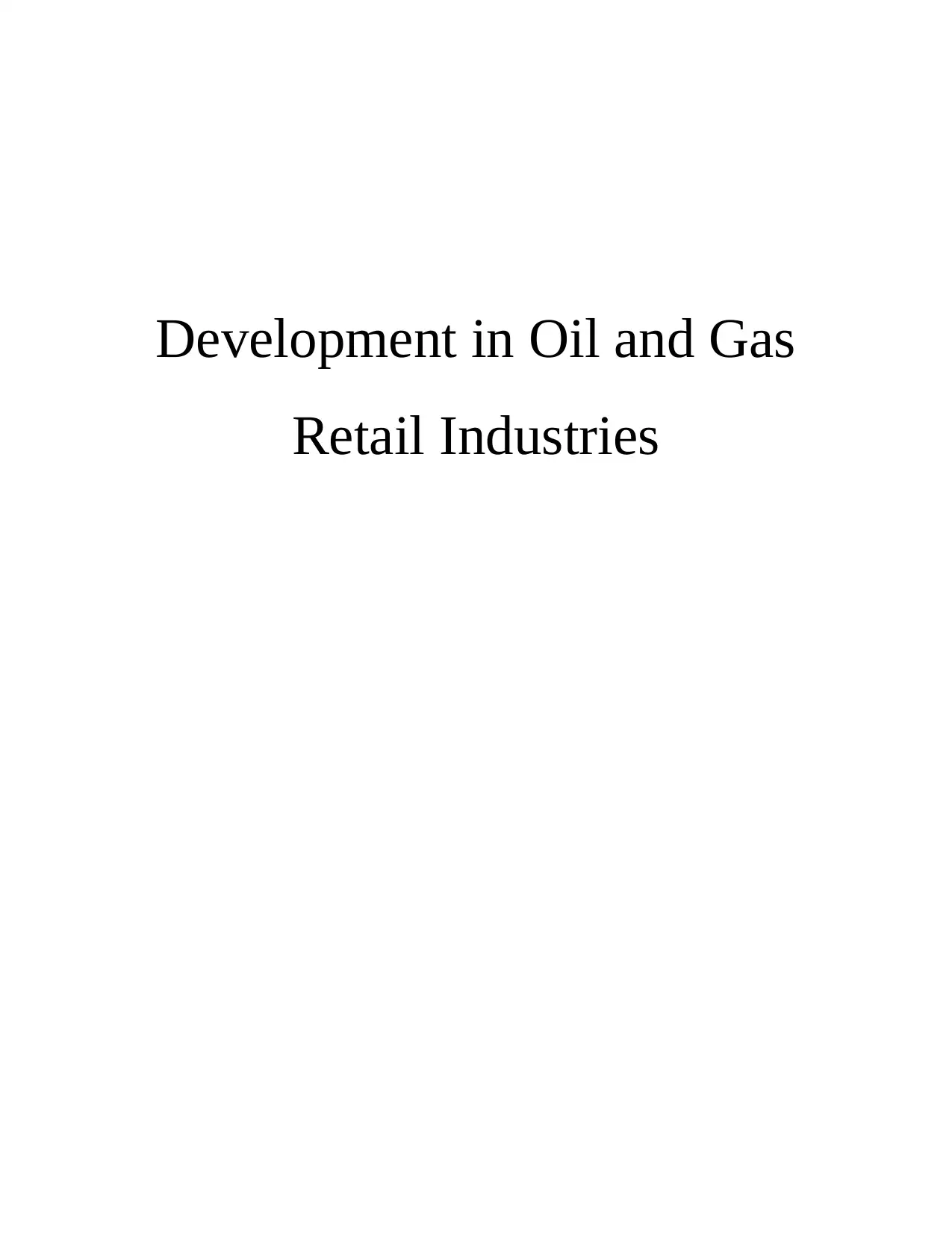
Development in Oil and Gas
Retail Industries
Retail Industries
Paraphrase This Document
Need a fresh take? Get an instant paraphrase of this document with our AI Paraphraser
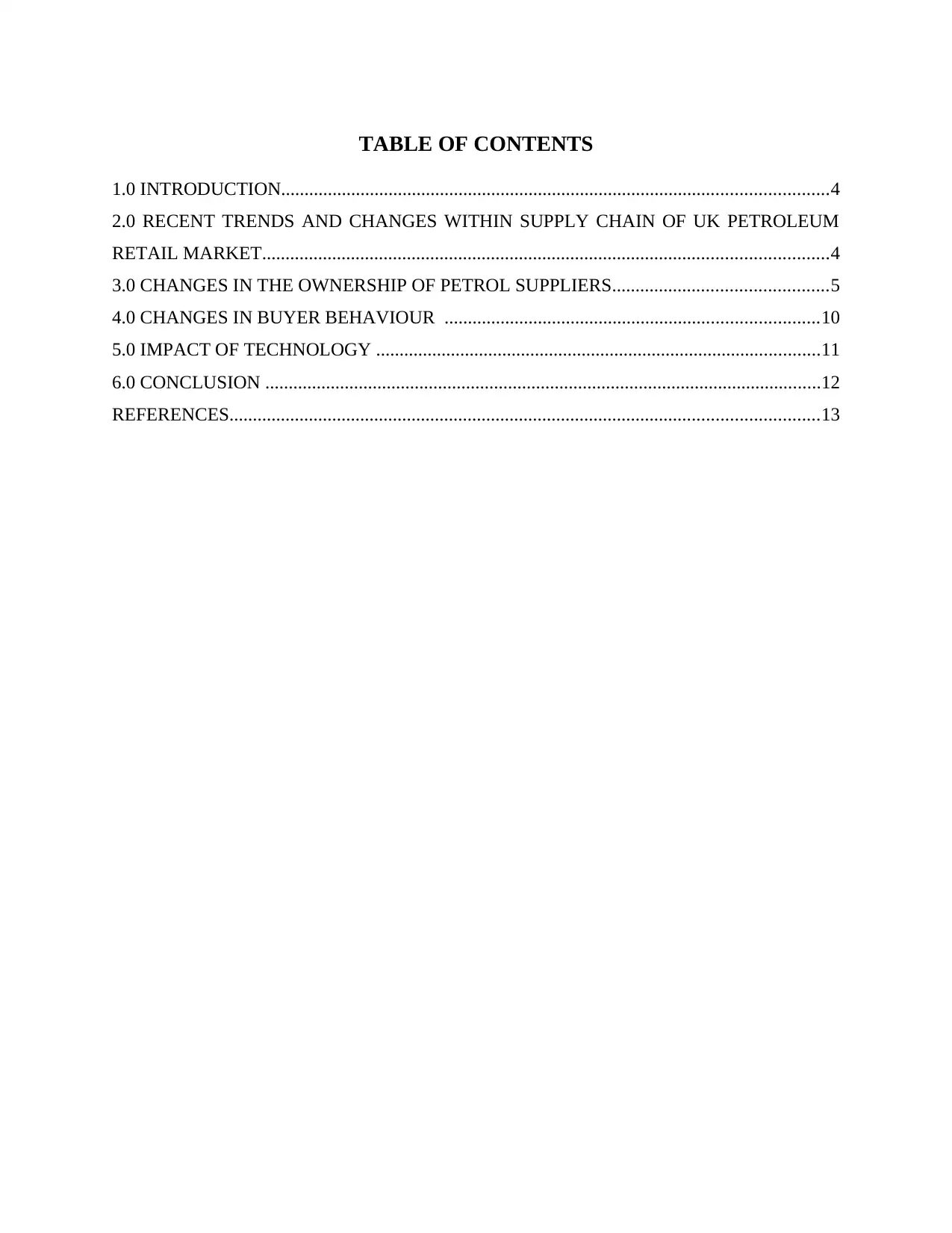
TABLE OF CONTENTS
1.0 INTRODUCTION.....................................................................................................................4
2.0 RECENT TRENDS AND CHANGES WITHIN SUPPLY CHAIN OF UK PETROLEUM
RETAIL MARKET.........................................................................................................................4
3.0 CHANGES IN THE OWNERSHIP OF PETROL SUPPLIERS..............................................5
4.0 CHANGES IN BUYER BEHAVIOUR ................................................................................10
5.0 IMPACT OF TECHNOLOGY ...............................................................................................11
6.0 CONCLUSION .......................................................................................................................12
REFERENCES..............................................................................................................................13
1.0 INTRODUCTION.....................................................................................................................4
2.0 RECENT TRENDS AND CHANGES WITHIN SUPPLY CHAIN OF UK PETROLEUM
RETAIL MARKET.........................................................................................................................4
3.0 CHANGES IN THE OWNERSHIP OF PETROL SUPPLIERS..............................................5
4.0 CHANGES IN BUYER BEHAVIOUR ................................................................................10
5.0 IMPACT OF TECHNOLOGY ...............................................................................................11
6.0 CONCLUSION .......................................................................................................................12
REFERENCES..............................................................................................................................13

ILLUSTRATION INDEX
Illustration 1: Declining of PFS in past decades..............................................................................6
Illustration 2: Asda PFS...................................................................................................................7
Illustration 3: Rising of petrol prices of different companies..........................................................8
Illustration 4: Total number of PFS and total fuel volumes.............................................................9
Illustration 1: Declining of PFS in past decades..............................................................................6
Illustration 2: Asda PFS...................................................................................................................7
Illustration 3: Rising of petrol prices of different companies..........................................................8
Illustration 4: Total number of PFS and total fuel volumes.............................................................9
You're viewing a preview
Unlock full access by subscribing today!
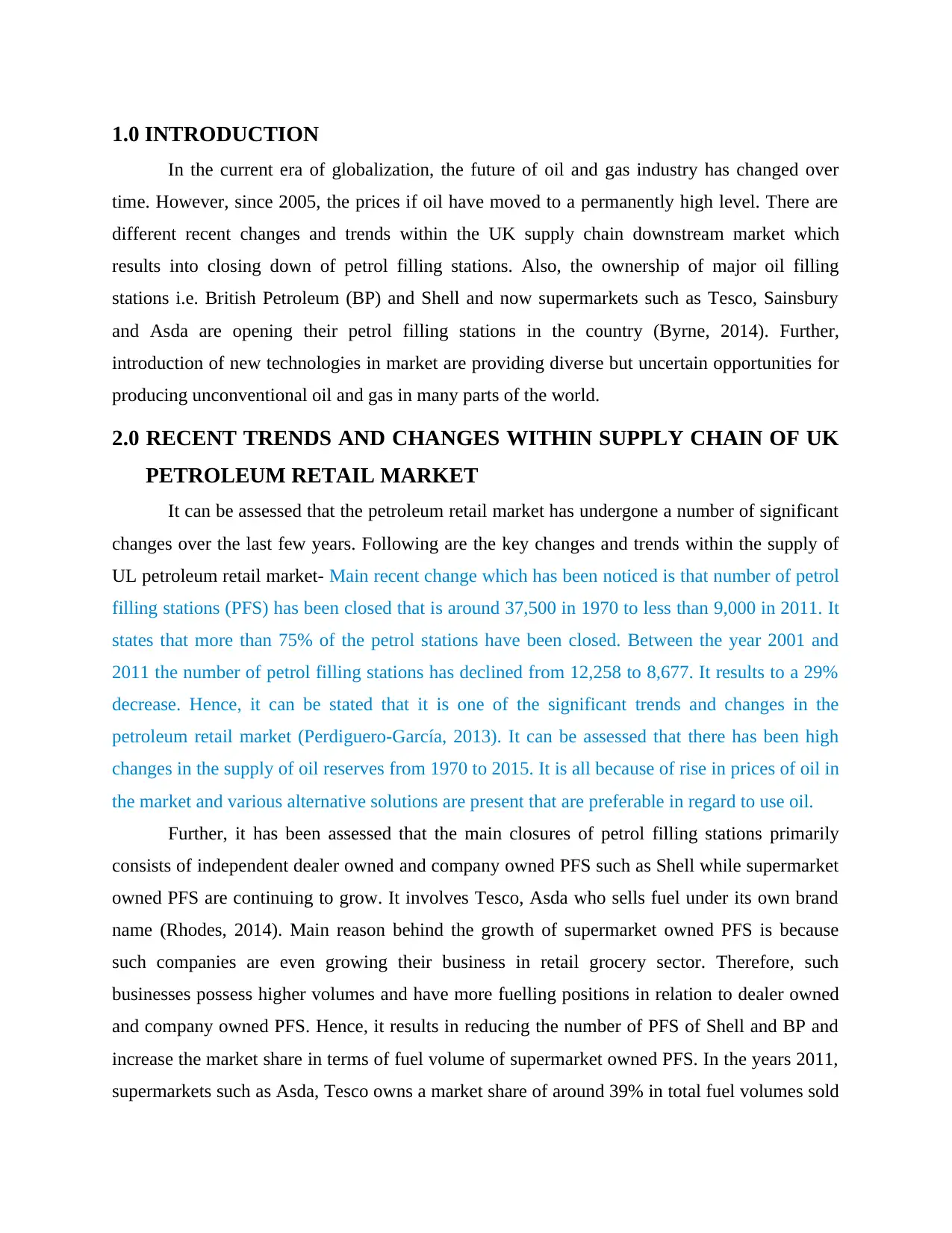
1.0 INTRODUCTION
In the current era of globalization, the future of oil and gas industry has changed over
time. However, since 2005, the prices if oil have moved to a permanently high level. There are
different recent changes and trends within the UK supply chain downstream market which
results into closing down of petrol filling stations. Also, the ownership of major oil filling
stations i.e. British Petroleum (BP) and Shell and now supermarkets such as Tesco, Sainsbury
and Asda are opening their petrol filling stations in the country (Byrne, 2014). Further,
introduction of new technologies in market are providing diverse but uncertain opportunities for
producing unconventional oil and gas in many parts of the world.
2.0 RECENT TRENDS AND CHANGES WITHIN SUPPLY CHAIN OF UK
PETROLEUM RETAIL MARKET
It can be assessed that the petroleum retail market has undergone a number of significant
changes over the last few years. Following are the key changes and trends within the supply of
UL petroleum retail market- Main recent change which has been noticed is that number of petrol
filling stations (PFS) has been closed that is around 37,500 in 1970 to less than 9,000 in 2011. It
states that more than 75% of the petrol stations have been closed. Between the year 2001 and
2011 the number of petrol filling stations has declined from 12,258 to 8,677. It results to a 29%
decrease. Hence, it can be stated that it is one of the significant trends and changes in the
petroleum retail market (Perdiguero-García, 2013). It can be assessed that there has been high
changes in the supply of oil reserves from 1970 to 2015. It is all because of rise in prices of oil in
the market and various alternative solutions are present that are preferable in regard to use oil.
Further, it has been assessed that the main closures of petrol filling stations primarily
consists of independent dealer owned and company owned PFS such as Shell while supermarket
owned PFS are continuing to grow. It involves Tesco, Asda who sells fuel under its own brand
name (Rhodes, 2014). Main reason behind the growth of supermarket owned PFS is because
such companies are even growing their business in retail grocery sector. Therefore, such
businesses possess higher volumes and have more fuelling positions in relation to dealer owned
and company owned PFS. Hence, it results in reducing the number of PFS of Shell and BP and
increase the market share in terms of fuel volume of supermarket owned PFS. In the years 2011,
supermarkets such as Asda, Tesco owns a market share of around 39% in total fuel volumes sold
In the current era of globalization, the future of oil and gas industry has changed over
time. However, since 2005, the prices if oil have moved to a permanently high level. There are
different recent changes and trends within the UK supply chain downstream market which
results into closing down of petrol filling stations. Also, the ownership of major oil filling
stations i.e. British Petroleum (BP) and Shell and now supermarkets such as Tesco, Sainsbury
and Asda are opening their petrol filling stations in the country (Byrne, 2014). Further,
introduction of new technologies in market are providing diverse but uncertain opportunities for
producing unconventional oil and gas in many parts of the world.
2.0 RECENT TRENDS AND CHANGES WITHIN SUPPLY CHAIN OF UK
PETROLEUM RETAIL MARKET
It can be assessed that the petroleum retail market has undergone a number of significant
changes over the last few years. Following are the key changes and trends within the supply of
UL petroleum retail market- Main recent change which has been noticed is that number of petrol
filling stations (PFS) has been closed that is around 37,500 in 1970 to less than 9,000 in 2011. It
states that more than 75% of the petrol stations have been closed. Between the year 2001 and
2011 the number of petrol filling stations has declined from 12,258 to 8,677. It results to a 29%
decrease. Hence, it can be stated that it is one of the significant trends and changes in the
petroleum retail market (Perdiguero-García, 2013). It can be assessed that there has been high
changes in the supply of oil reserves from 1970 to 2015. It is all because of rise in prices of oil in
the market and various alternative solutions are present that are preferable in regard to use oil.
Further, it has been assessed that the main closures of petrol filling stations primarily
consists of independent dealer owned and company owned PFS such as Shell while supermarket
owned PFS are continuing to grow. It involves Tesco, Asda who sells fuel under its own brand
name (Rhodes, 2014). Main reason behind the growth of supermarket owned PFS is because
such companies are even growing their business in retail grocery sector. Therefore, such
businesses possess higher volumes and have more fuelling positions in relation to dealer owned
and company owned PFS. Hence, it results in reducing the number of PFS of Shell and BP and
increase the market share in terms of fuel volume of supermarket owned PFS. In the years 2011,
supermarkets such as Asda, Tesco owns a market share of around 39% in total fuel volumes sold
Paraphrase This Document
Need a fresh take? Get an instant paraphrase of this document with our AI Paraphraser
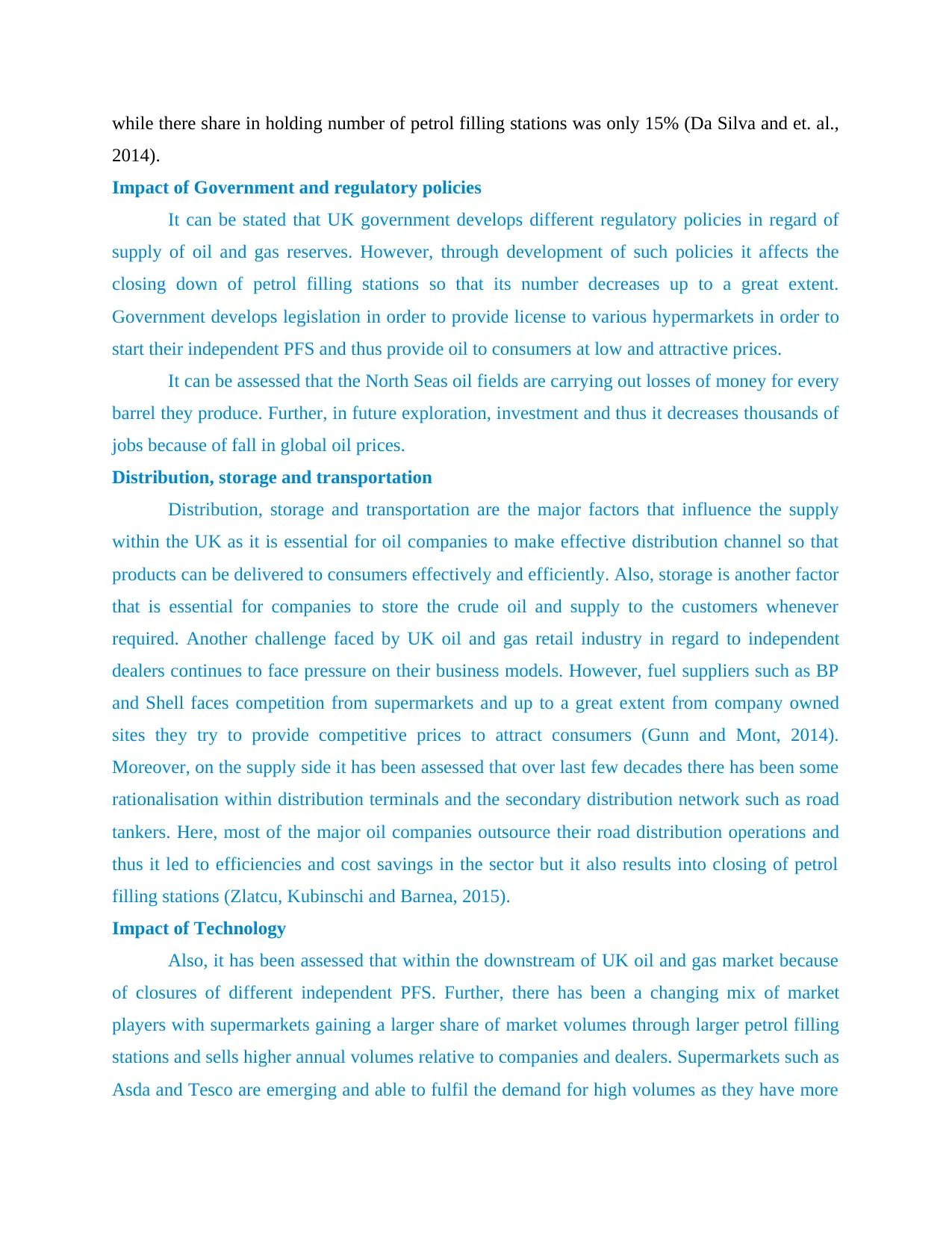
while there share in holding number of petrol filling stations was only 15% (Da Silva and et. al.,
2014).
Impact of Government and regulatory policies
It can be stated that UK government develops different regulatory policies in regard of
supply of oil and gas reserves. However, through development of such policies it affects the
closing down of petrol filling stations so that its number decreases up to a great extent.
Government develops legislation in order to provide license to various hypermarkets in order to
start their independent PFS and thus provide oil to consumers at low and attractive prices.
It can be assessed that the North Seas oil fields are carrying out losses of money for every
barrel they produce. Further, in future exploration, investment and thus it decreases thousands of
jobs because of fall in global oil prices.
Distribution, storage and transportation
Distribution, storage and transportation are the major factors that influence the supply
within the UK as it is essential for oil companies to make effective distribution channel so that
products can be delivered to consumers effectively and efficiently. Also, storage is another factor
that is essential for companies to store the crude oil and supply to the customers whenever
required. Another challenge faced by UK oil and gas retail industry in regard to independent
dealers continues to face pressure on their business models. However, fuel suppliers such as BP
and Shell faces competition from supermarkets and up to a great extent from company owned
sites they try to provide competitive prices to attract consumers (Gunn and Mont, 2014).
Moreover, on the supply side it has been assessed that over last few decades there has been some
rationalisation within distribution terminals and the secondary distribution network such as road
tankers. Here, most of the major oil companies outsource their road distribution operations and
thus it led to efficiencies and cost savings in the sector but it also results into closing of petrol
filling stations (Zlatcu, Kubinschi and Barnea, 2015).
Impact of Technology
Also, it has been assessed that within the downstream of UK oil and gas market because
of closures of different independent PFS. Further, there has been a changing mix of market
players with supermarkets gaining a larger share of market volumes through larger petrol filling
stations and sells higher annual volumes relative to companies and dealers. Supermarkets such as
Asda and Tesco are emerging and able to fulfil the demand for high volumes as they have more
2014).
Impact of Government and regulatory policies
It can be stated that UK government develops different regulatory policies in regard of
supply of oil and gas reserves. However, through development of such policies it affects the
closing down of petrol filling stations so that its number decreases up to a great extent.
Government develops legislation in order to provide license to various hypermarkets in order to
start their independent PFS and thus provide oil to consumers at low and attractive prices.
It can be assessed that the North Seas oil fields are carrying out losses of money for every
barrel they produce. Further, in future exploration, investment and thus it decreases thousands of
jobs because of fall in global oil prices.
Distribution, storage and transportation
Distribution, storage and transportation are the major factors that influence the supply
within the UK as it is essential for oil companies to make effective distribution channel so that
products can be delivered to consumers effectively and efficiently. Also, storage is another factor
that is essential for companies to store the crude oil and supply to the customers whenever
required. Another challenge faced by UK oil and gas retail industry in regard to independent
dealers continues to face pressure on their business models. However, fuel suppliers such as BP
and Shell faces competition from supermarkets and up to a great extent from company owned
sites they try to provide competitive prices to attract consumers (Gunn and Mont, 2014).
Moreover, on the supply side it has been assessed that over last few decades there has been some
rationalisation within distribution terminals and the secondary distribution network such as road
tankers. Here, most of the major oil companies outsource their road distribution operations and
thus it led to efficiencies and cost savings in the sector but it also results into closing of petrol
filling stations (Zlatcu, Kubinschi and Barnea, 2015).
Impact of Technology
Also, it has been assessed that within the downstream of UK oil and gas market because
of closures of different independent PFS. Further, there has been a changing mix of market
players with supermarkets gaining a larger share of market volumes through larger petrol filling
stations and sells higher annual volumes relative to companies and dealers. Supermarkets such as
Asda and Tesco are emerging and able to fulfil the demand for high volumes as they have more

storage capacity (Valadkhani, Smyth and Vahid, 2015). Further, government also introduces
effective technology such as oil tankers using bio gas fuel and do not uses oil or petrol that helps
in making cost effective supply. Another change introduced in the supply of UK petroleum
market is that there has been considerable fragmentation in the fuel supply chain over last few
years. It involves rationalisation of storage terminals, outsourcing of fuel road distribution
network and introducing innovative technology etc (Polemis and Fotis, 2014).
3.0 CHANGES IN THE OWNERSHIP OF PETROL SUPPLIERS
It has been identified that because of entry and growth of supermarkets in the fuel
retailing business it helps in providing tough competition to other major suppliers such as BP and
Shell. Hypermarkets such as Tesco and Asda own around 14% of petrol filling stations within
UK but they supply more than 40% of total road fuel volumes. Therefore, as compared to their
market share they are high in fuel volumes (Alderighi and Baudino, 2015). Thus, it puts
competitive pressures upon independent petrol filling stations such as Shell and oil companies
like BP. Within the last 1 decade, oil companies have decreased their market share in fuel
retailing. For instance, through a recent survey by the oil and gas industry, Tesco has recently
overcome BP as the largest retailer in terms of fuel volumes sold. It has been identified that PFS
owned by retail industries are consistent because of growth of supermarkets in the grocery
retailing business (Jones, Hillier and Comfort, 2015). Furthermore, retail businesses keep their
prices minimum as compared to BP and Shell and thus consumers prefer more to purchase fuel
from such hypermarkets owned PFS. Hypermarkets also introduce different attractive price
discounts at several times in order to attract customers and increase footfall within their retail
stores.
effective technology such as oil tankers using bio gas fuel and do not uses oil or petrol that helps
in making cost effective supply. Another change introduced in the supply of UK petroleum
market is that there has been considerable fragmentation in the fuel supply chain over last few
years. It involves rationalisation of storage terminals, outsourcing of fuel road distribution
network and introducing innovative technology etc (Polemis and Fotis, 2014).
3.0 CHANGES IN THE OWNERSHIP OF PETROL SUPPLIERS
It has been identified that because of entry and growth of supermarkets in the fuel
retailing business it helps in providing tough competition to other major suppliers such as BP and
Shell. Hypermarkets such as Tesco and Asda own around 14% of petrol filling stations within
UK but they supply more than 40% of total road fuel volumes. Therefore, as compared to their
market share they are high in fuel volumes (Alderighi and Baudino, 2015). Thus, it puts
competitive pressures upon independent petrol filling stations such as Shell and oil companies
like BP. Within the last 1 decade, oil companies have decreased their market share in fuel
retailing. For instance, through a recent survey by the oil and gas industry, Tesco has recently
overcome BP as the largest retailer in terms of fuel volumes sold. It has been identified that PFS
owned by retail industries are consistent because of growth of supermarkets in the grocery
retailing business (Jones, Hillier and Comfort, 2015). Furthermore, retail businesses keep their
prices minimum as compared to BP and Shell and thus consumers prefer more to purchase fuel
from such hypermarkets owned PFS. Hypermarkets also introduce different attractive price
discounts at several times in order to attract customers and increase footfall within their retail
stores.
You're viewing a preview
Unlock full access by subscribing today!
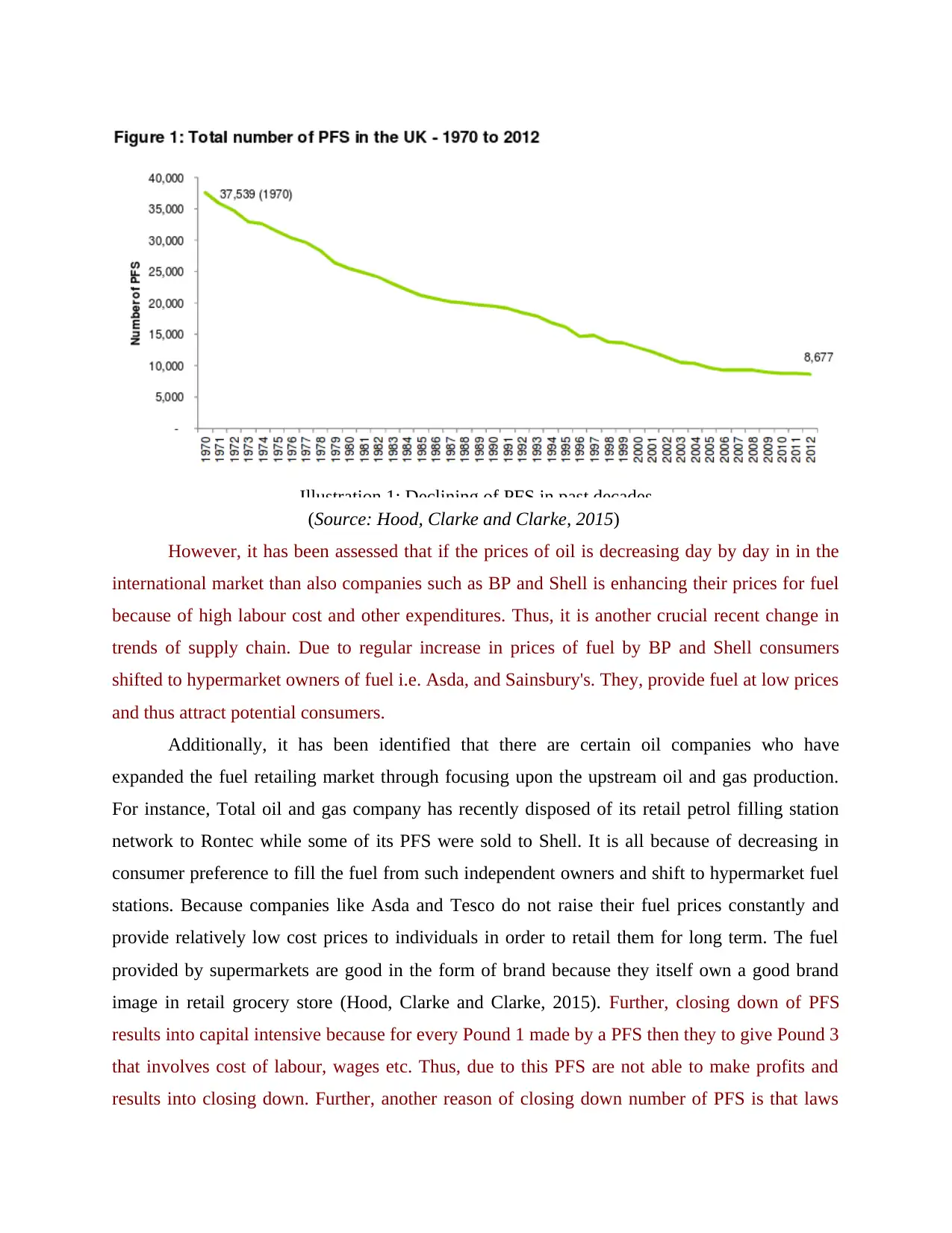
Illustration 1: Declining of PFS in past decades
(Source: Hood, Clarke and Clarke, 2015)
However, it has been assessed that if the prices of oil is decreasing day by day in in the
international market than also companies such as BP and Shell is enhancing their prices for fuel
because of high labour cost and other expenditures. Thus, it is another crucial recent change in
trends of supply chain. Due to regular increase in prices of fuel by BP and Shell consumers
shifted to hypermarket owners of fuel i.e. Asda, and Sainsbury's. They, provide fuel at low prices
and thus attract potential consumers.
Additionally, it has been identified that there are certain oil companies who have
expanded the fuel retailing market through focusing upon the upstream oil and gas production.
For instance, Total oil and gas company has recently disposed of its retail petrol filling station
network to Rontec while some of its PFS were sold to Shell. It is all because of decreasing in
consumer preference to fill the fuel from such independent owners and shift to hypermarket fuel
stations. Because companies like Asda and Tesco do not raise their fuel prices constantly and
provide relatively low cost prices to individuals in order to retail them for long term. The fuel
provided by supermarkets are good in the form of brand because they itself own a good brand
image in retail grocery store (Hood, Clarke and Clarke, 2015). Further, closing down of PFS
results into capital intensive because for every Pound 1 made by a PFS then they to give Pound 3
that involves cost of labour, wages etc. Thus, due to this PFS are not able to make profits and
results into closing down. Further, another reason of closing down number of PFS is that laws
(Source: Hood, Clarke and Clarke, 2015)
However, it has been assessed that if the prices of oil is decreasing day by day in in the
international market than also companies such as BP and Shell is enhancing their prices for fuel
because of high labour cost and other expenditures. Thus, it is another crucial recent change in
trends of supply chain. Due to regular increase in prices of fuel by BP and Shell consumers
shifted to hypermarket owners of fuel i.e. Asda, and Sainsbury's. They, provide fuel at low prices
and thus attract potential consumers.
Additionally, it has been identified that there are certain oil companies who have
expanded the fuel retailing market through focusing upon the upstream oil and gas production.
For instance, Total oil and gas company has recently disposed of its retail petrol filling station
network to Rontec while some of its PFS were sold to Shell. It is all because of decreasing in
consumer preference to fill the fuel from such independent owners and shift to hypermarket fuel
stations. Because companies like Asda and Tesco do not raise their fuel prices constantly and
provide relatively low cost prices to individuals in order to retail them for long term. The fuel
provided by supermarkets are good in the form of brand because they itself own a good brand
image in retail grocery store (Hood, Clarke and Clarke, 2015). Further, closing down of PFS
results into capital intensive because for every Pound 1 made by a PFS then they to give Pound 3
that involves cost of labour, wages etc. Thus, due to this PFS are not able to make profits and
results into closing down. Further, another reason of closing down number of PFS is that laws
Paraphrase This Document
Need a fresh take? Get an instant paraphrase of this document with our AI Paraphraser
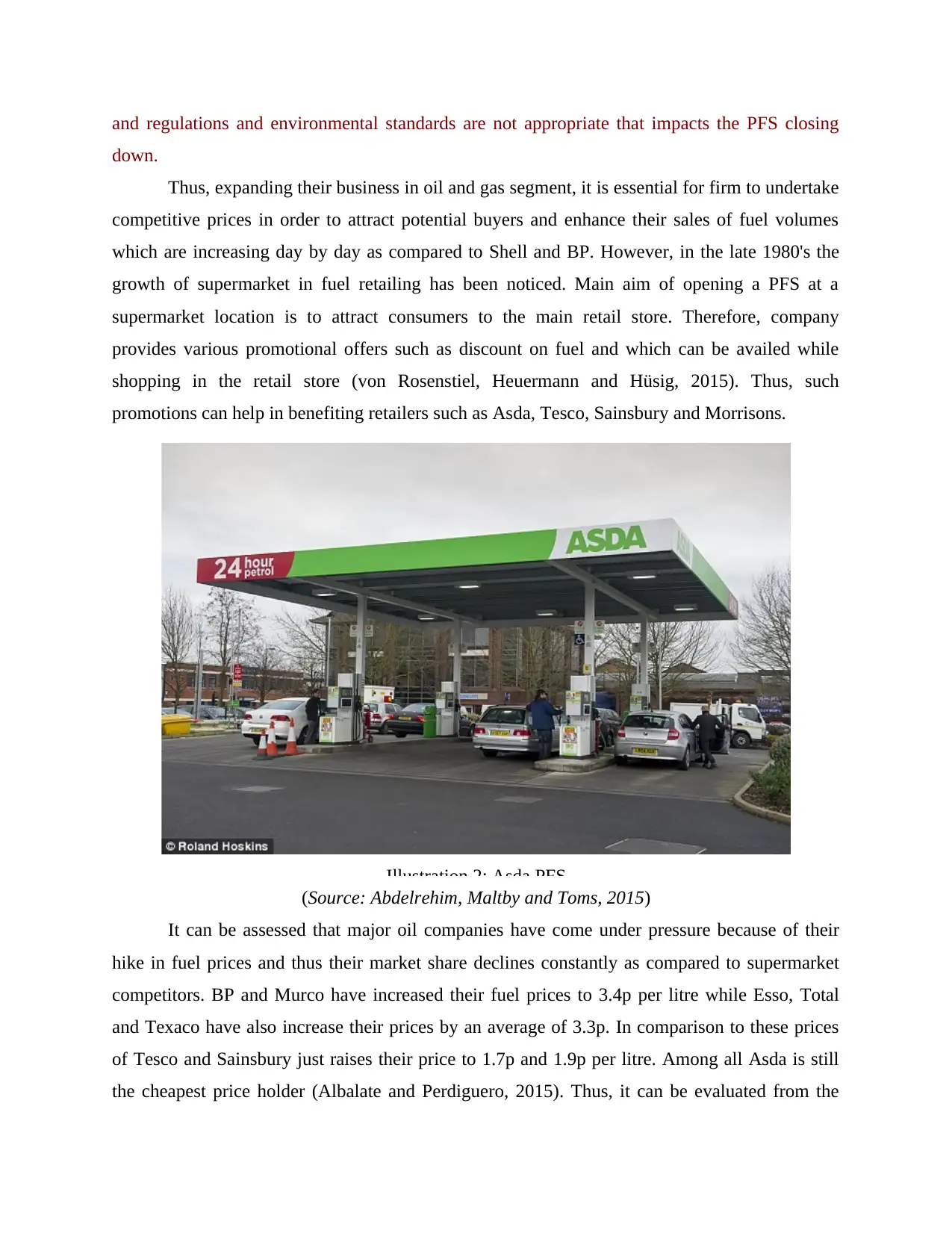
and regulations and environmental standards are not appropriate that impacts the PFS closing
down.
Thus, expanding their business in oil and gas segment, it is essential for firm to undertake
competitive prices in order to attract potential buyers and enhance their sales of fuel volumes
which are increasing day by day as compared to Shell and BP. However, in the late 1980's the
growth of supermarket in fuel retailing has been noticed. Main aim of opening a PFS at a
supermarket location is to attract consumers to the main retail store. Therefore, company
provides various promotional offers such as discount on fuel and which can be availed while
shopping in the retail store (von Rosenstiel, Heuermann and Hüsig, 2015). Thus, such
promotions can help in benefiting retailers such as Asda, Tesco, Sainsbury and Morrisons.
Illustration 2: Asda PFS
(Source: Abdelrehim, Maltby and Toms, 2015)
It can be assessed that major oil companies have come under pressure because of their
hike in fuel prices and thus their market share declines constantly as compared to supermarket
competitors. BP and Murco have increased their fuel prices to 3.4p per litre while Esso, Total
and Texaco have also increase their prices by an average of 3.3p. In comparison to these prices
of Tesco and Sainsbury just raises their price to 1.7p and 1.9p per litre. Among all Asda is still
the cheapest price holder (Albalate and Perdiguero, 2015). Thus, it can be evaluated from the
down.
Thus, expanding their business in oil and gas segment, it is essential for firm to undertake
competitive prices in order to attract potential buyers and enhance their sales of fuel volumes
which are increasing day by day as compared to Shell and BP. However, in the late 1980's the
growth of supermarket in fuel retailing has been noticed. Main aim of opening a PFS at a
supermarket location is to attract consumers to the main retail store. Therefore, company
provides various promotional offers such as discount on fuel and which can be availed while
shopping in the retail store (von Rosenstiel, Heuermann and Hüsig, 2015). Thus, such
promotions can help in benefiting retailers such as Asda, Tesco, Sainsbury and Morrisons.
Illustration 2: Asda PFS
(Source: Abdelrehim, Maltby and Toms, 2015)
It can be assessed that major oil companies have come under pressure because of their
hike in fuel prices and thus their market share declines constantly as compared to supermarket
competitors. BP and Murco have increased their fuel prices to 3.4p per litre while Esso, Total
and Texaco have also increase their prices by an average of 3.3p. In comparison to these prices
of Tesco and Sainsbury just raises their price to 1.7p and 1.9p per litre. Among all Asda is still
the cheapest price holder (Albalate and Perdiguero, 2015). Thus, it can be evaluated from the

below table that there are different oil companies providing different price range for fuel. But it
shows that hypermarket owners provide fuel at relatively low prices as compared to other
independent owners such as BP and Shell. Therefore, consumers are more likely to purchase fuel
from PFS of Asda. Tesco and Salisbury because they also provide attractive discount prices to
attract potential consumers to visit their retail store and enhance the sales of grocery as well
(Wang, 2015).
Illustration 3: Rising of petrol prices of different companies
(Source: Mitchell, 2012)
Further, it has been assessed from below graph that as compared to company and dealers
hypermarket has high share of total fuel volumes which is around 39%. While, % of total PFS
numbers involve 85% including both company and dealers. Thus, for each ownership type there
are significant differences in their share of total fuel volume sold which is relative to their share
of the total number of PFS (Mitchell, 2012).
shows that hypermarket owners provide fuel at relatively low prices as compared to other
independent owners such as BP and Shell. Therefore, consumers are more likely to purchase fuel
from PFS of Asda. Tesco and Salisbury because they also provide attractive discount prices to
attract potential consumers to visit their retail store and enhance the sales of grocery as well
(Wang, 2015).
Illustration 3: Rising of petrol prices of different companies
(Source: Mitchell, 2012)
Further, it has been assessed from below graph that as compared to company and dealers
hypermarket has high share of total fuel volumes which is around 39%. While, % of total PFS
numbers involve 85% including both company and dealers. Thus, for each ownership type there
are significant differences in their share of total fuel volume sold which is relative to their share
of the total number of PFS (Mitchell, 2012).
You're viewing a preview
Unlock full access by subscribing today!
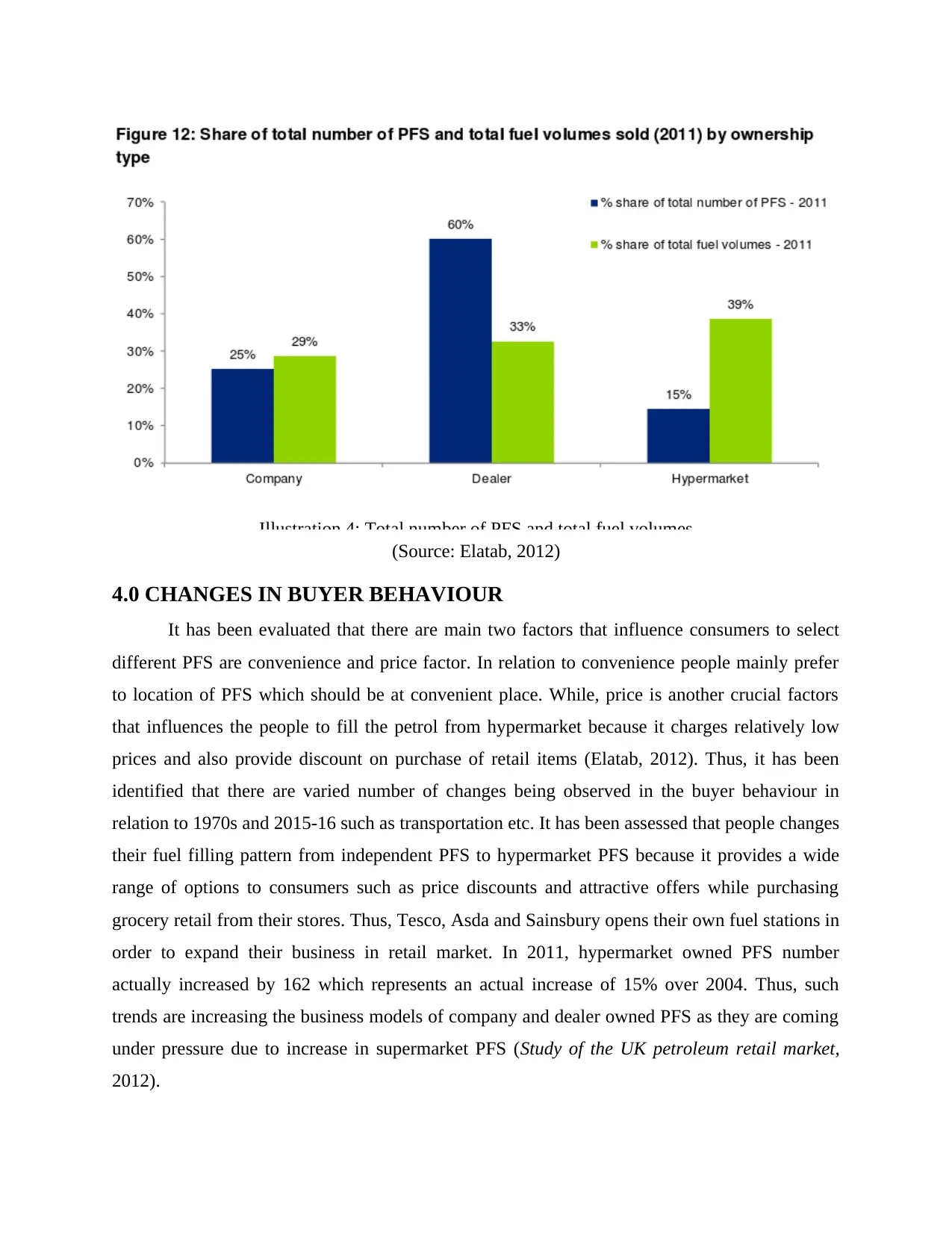
Illustration 4: Total number of PFS and total fuel volumes
(Source: Elatab, 2012)
4.0 CHANGES IN BUYER BEHAVIOUR
It has been evaluated that there are main two factors that influence consumers to select
different PFS are convenience and price factor. In relation to convenience people mainly prefer
to location of PFS which should be at convenient place. While, price is another crucial factors
that influences the people to fill the petrol from hypermarket because it charges relatively low
prices and also provide discount on purchase of retail items (Elatab, 2012). Thus, it has been
identified that there are varied number of changes being observed in the buyer behaviour in
relation to 1970s and 2015-16 such as transportation etc. It has been assessed that people changes
their fuel filling pattern from independent PFS to hypermarket PFS because it provides a wide
range of options to consumers such as price discounts and attractive offers while purchasing
grocery retail from their stores. Thus, Tesco, Asda and Sainsbury opens their own fuel stations in
order to expand their business in retail market. In 2011, hypermarket owned PFS number
actually increased by 162 which represents an actual increase of 15% over 2004. Thus, such
trends are increasing the business models of company and dealer owned PFS as they are coming
under pressure due to increase in supermarket PFS (Study of the UK petroleum retail market,
2012).
(Source: Elatab, 2012)
4.0 CHANGES IN BUYER BEHAVIOUR
It has been evaluated that there are main two factors that influence consumers to select
different PFS are convenience and price factor. In relation to convenience people mainly prefer
to location of PFS which should be at convenient place. While, price is another crucial factors
that influences the people to fill the petrol from hypermarket because it charges relatively low
prices and also provide discount on purchase of retail items (Elatab, 2012). Thus, it has been
identified that there are varied number of changes being observed in the buyer behaviour in
relation to 1970s and 2015-16 such as transportation etc. It has been assessed that people changes
their fuel filling pattern from independent PFS to hypermarket PFS because it provides a wide
range of options to consumers such as price discounts and attractive offers while purchasing
grocery retail from their stores. Thus, Tesco, Asda and Sainsbury opens their own fuel stations in
order to expand their business in retail market. In 2011, hypermarket owned PFS number
actually increased by 162 which represents an actual increase of 15% over 2004. Thus, such
trends are increasing the business models of company and dealer owned PFS as they are coming
under pressure due to increase in supermarket PFS (Study of the UK petroleum retail market,
2012).
Paraphrase This Document
Need a fresh take? Get an instant paraphrase of this document with our AI Paraphraser
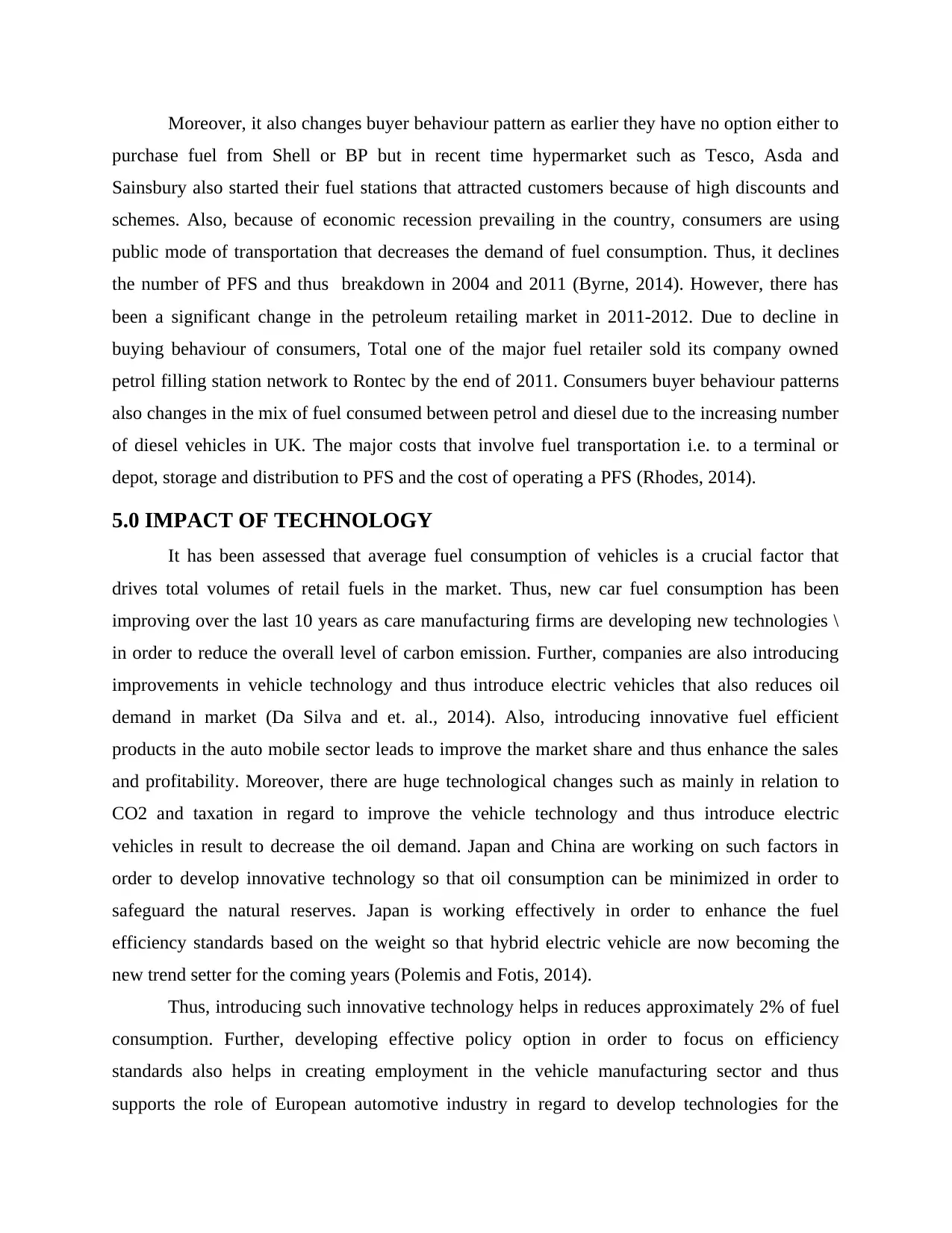
Moreover, it also changes buyer behaviour pattern as earlier they have no option either to
purchase fuel from Shell or BP but in recent time hypermarket such as Tesco, Asda and
Sainsbury also started their fuel stations that attracted customers because of high discounts and
schemes. Also, because of economic recession prevailing in the country, consumers are using
public mode of transportation that decreases the demand of fuel consumption. Thus, it declines
the number of PFS and thus breakdown in 2004 and 2011 (Byrne, 2014). However, there has
been a significant change in the petroleum retailing market in 2011-2012. Due to decline in
buying behaviour of consumers, Total one of the major fuel retailer sold its company owned
petrol filling station network to Rontec by the end of 2011. Consumers buyer behaviour patterns
also changes in the mix of fuel consumed between petrol and diesel due to the increasing number
of diesel vehicles in UK. The major costs that involve fuel transportation i.e. to a terminal or
depot, storage and distribution to PFS and the cost of operating a PFS (Rhodes, 2014).
5.0 IMPACT OF TECHNOLOGY
It has been assessed that average fuel consumption of vehicles is a crucial factor that
drives total volumes of retail fuels in the market. Thus, new car fuel consumption has been
improving over the last 10 years as care manufacturing firms are developing new technologies \
in order to reduce the overall level of carbon emission. Further, companies are also introducing
improvements in vehicle technology and thus introduce electric vehicles that also reduces oil
demand in market (Da Silva and et. al., 2014). Also, introducing innovative fuel efficient
products in the auto mobile sector leads to improve the market share and thus enhance the sales
and profitability. Moreover, there are huge technological changes such as mainly in relation to
CO2 and taxation in regard to improve the vehicle technology and thus introduce electric
vehicles in result to decrease the oil demand. Japan and China are working on such factors in
order to develop innovative technology so that oil consumption can be minimized in order to
safeguard the natural reserves. Japan is working effectively in order to enhance the fuel
efficiency standards based on the weight so that hybrid electric vehicle are now becoming the
new trend setter for the coming years (Polemis and Fotis, 2014).
Thus, introducing such innovative technology helps in reduces approximately 2% of fuel
consumption. Further, developing effective policy option in order to focus on efficiency
standards also helps in creating employment in the vehicle manufacturing sector and thus
supports the role of European automotive industry in regard to develop technologies for the
purchase fuel from Shell or BP but in recent time hypermarket such as Tesco, Asda and
Sainsbury also started their fuel stations that attracted customers because of high discounts and
schemes. Also, because of economic recession prevailing in the country, consumers are using
public mode of transportation that decreases the demand of fuel consumption. Thus, it declines
the number of PFS and thus breakdown in 2004 and 2011 (Byrne, 2014). However, there has
been a significant change in the petroleum retailing market in 2011-2012. Due to decline in
buying behaviour of consumers, Total one of the major fuel retailer sold its company owned
petrol filling station network to Rontec by the end of 2011. Consumers buyer behaviour patterns
also changes in the mix of fuel consumed between petrol and diesel due to the increasing number
of diesel vehicles in UK. The major costs that involve fuel transportation i.e. to a terminal or
depot, storage and distribution to PFS and the cost of operating a PFS (Rhodes, 2014).
5.0 IMPACT OF TECHNOLOGY
It has been assessed that average fuel consumption of vehicles is a crucial factor that
drives total volumes of retail fuels in the market. Thus, new car fuel consumption has been
improving over the last 10 years as care manufacturing firms are developing new technologies \
in order to reduce the overall level of carbon emission. Further, companies are also introducing
improvements in vehicle technology and thus introduce electric vehicles that also reduces oil
demand in market (Da Silva and et. al., 2014). Also, introducing innovative fuel efficient
products in the auto mobile sector leads to improve the market share and thus enhance the sales
and profitability. Moreover, there are huge technological changes such as mainly in relation to
CO2 and taxation in regard to improve the vehicle technology and thus introduce electric
vehicles in result to decrease the oil demand. Japan and China are working on such factors in
order to develop innovative technology so that oil consumption can be minimized in order to
safeguard the natural reserves. Japan is working effectively in order to enhance the fuel
efficiency standards based on the weight so that hybrid electric vehicle are now becoming the
new trend setter for the coming years (Polemis and Fotis, 2014).
Thus, introducing such innovative technology helps in reduces approximately 2% of fuel
consumption. Further, developing effective policy option in order to focus on efficiency
standards also helps in creating employment in the vehicle manufacturing sector and thus
supports the role of European automotive industry in regard to develop technologies for the
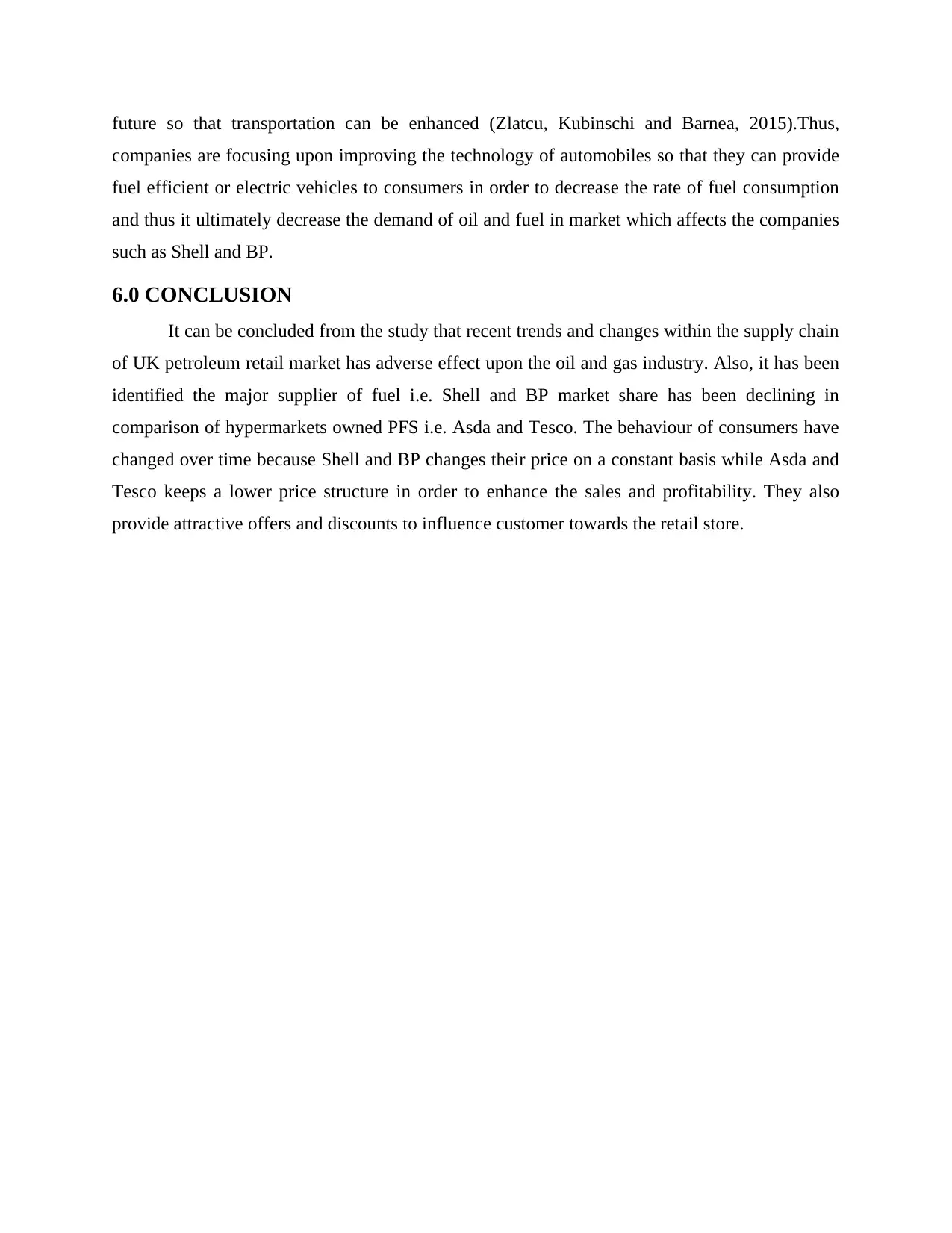
future so that transportation can be enhanced (Zlatcu, Kubinschi and Barnea, 2015).Thus,
companies are focusing upon improving the technology of automobiles so that they can provide
fuel efficient or electric vehicles to consumers in order to decrease the rate of fuel consumption
and thus it ultimately decrease the demand of oil and fuel in market which affects the companies
such as Shell and BP.
6.0 CONCLUSION
It can be concluded from the study that recent trends and changes within the supply chain
of UK petroleum retail market has adverse effect upon the oil and gas industry. Also, it has been
identified the major supplier of fuel i.e. Shell and BP market share has been declining in
comparison of hypermarkets owned PFS i.e. Asda and Tesco. The behaviour of consumers have
changed over time because Shell and BP changes their price on a constant basis while Asda and
Tesco keeps a lower price structure in order to enhance the sales and profitability. They also
provide attractive offers and discounts to influence customer towards the retail store.
companies are focusing upon improving the technology of automobiles so that they can provide
fuel efficient or electric vehicles to consumers in order to decrease the rate of fuel consumption
and thus it ultimately decrease the demand of oil and fuel in market which affects the companies
such as Shell and BP.
6.0 CONCLUSION
It can be concluded from the study that recent trends and changes within the supply chain
of UK petroleum retail market has adverse effect upon the oil and gas industry. Also, it has been
identified the major supplier of fuel i.e. Shell and BP market share has been declining in
comparison of hypermarkets owned PFS i.e. Asda and Tesco. The behaviour of consumers have
changed over time because Shell and BP changes their price on a constant basis while Asda and
Tesco keeps a lower price structure in order to enhance the sales and profitability. They also
provide attractive offers and discounts to influence customer towards the retail store.
You're viewing a preview
Unlock full access by subscribing today!
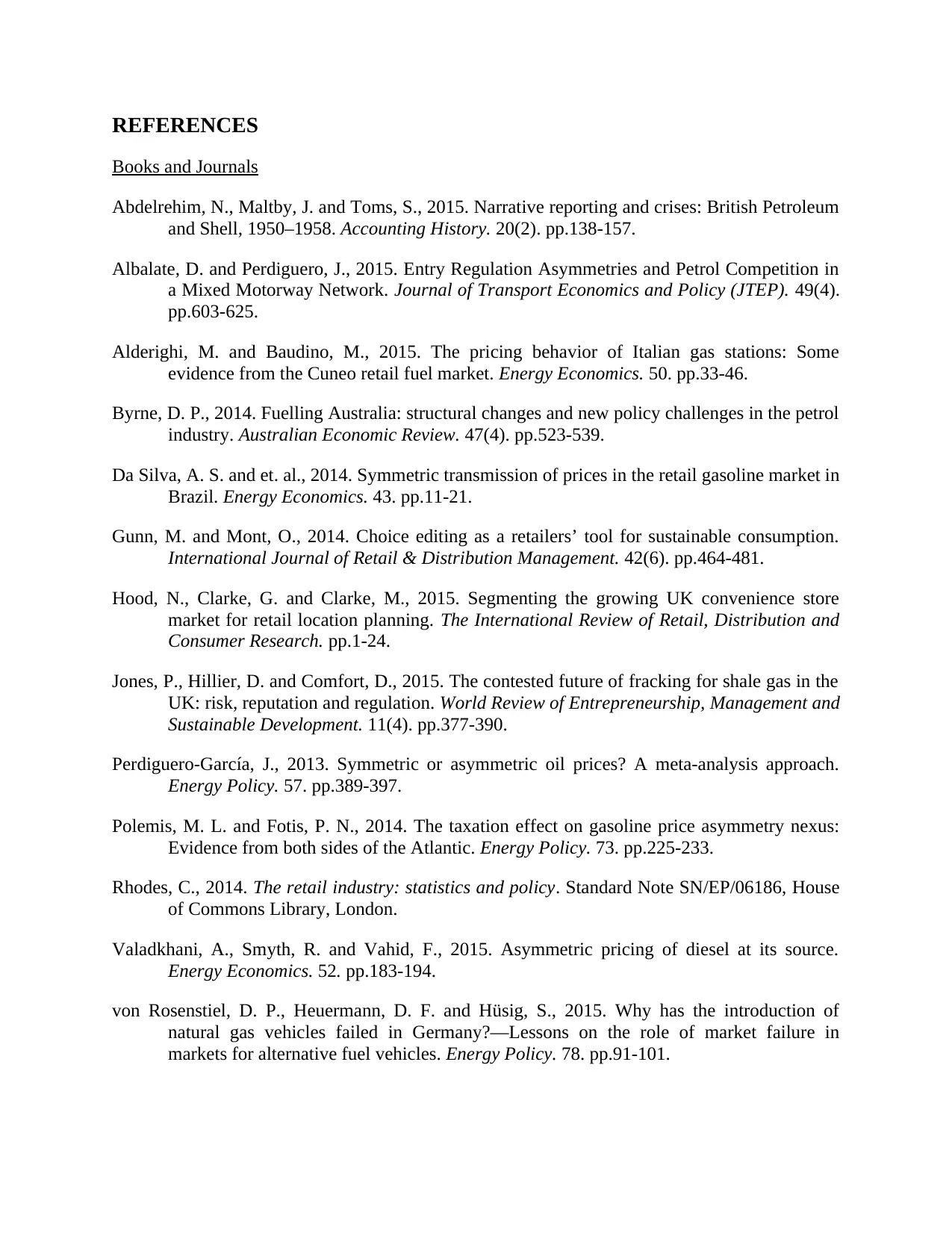
REFERENCES
Books and Journals
Abdelrehim, N., Maltby, J. and Toms, S., 2015. Narrative reporting and crises: British Petroleum
and Shell, 1950–1958. Accounting History. 20(2). pp.138-157.
Albalate, D. and Perdiguero, J., 2015. Entry Regulation Asymmetries and Petrol Competition in
a Mixed Motorway Network. Journal of Transport Economics and Policy (JTEP). 49(4).
pp.603-625.
Alderighi, M. and Baudino, M., 2015. The pricing behavior of Italian gas stations: Some
evidence from the Cuneo retail fuel market. Energy Economics. 50. pp.33-46.
Byrne, D. P., 2014. Fuelling Australia: structural changes and new policy challenges in the petrol
industry. Australian Economic Review. 47(4). pp.523-539.
Da Silva, A. S. and et. al., 2014. Symmetric transmission of prices in the retail gasoline market in
Brazil. Energy Economics. 43. pp.11-21.
Gunn, M. and Mont, O., 2014. Choice editing as a retailers’ tool for sustainable consumption.
International Journal of Retail & Distribution Management. 42(6). pp.464-481.
Hood, N., Clarke, G. and Clarke, M., 2015. Segmenting the growing UK convenience store
market for retail location planning. The International Review of Retail, Distribution and
Consumer Research. pp.1-24.
Jones, P., Hillier, D. and Comfort, D., 2015. The contested future of fracking for shale gas in the
UK: risk, reputation and regulation. World Review of Entrepreneurship, Management and
Sustainable Development. 11(4). pp.377-390.
Perdiguero-García, J., 2013. Symmetric or asymmetric oil prices? A meta-analysis approach.
Energy Policy. 57. pp.389-397.
Polemis, M. L. and Fotis, P. N., 2014. The taxation effect on gasoline price asymmetry nexus:
Evidence from both sides of the Atlantic. Energy Policy. 73. pp.225-233.
Rhodes, C., 2014. The retail industry: statistics and policy. Standard Note SN/EP/06186, House
of Commons Library, London.
Valadkhani, A., Smyth, R. and Vahid, F., 2015. Asymmetric pricing of diesel at its source.
Energy Economics. 52. pp.183-194.
von Rosenstiel, D. P., Heuermann, D. F. and Hüsig, S., 2015. Why has the introduction of
natural gas vehicles failed in Germany?—Lessons on the role of market failure in
markets for alternative fuel vehicles. Energy Policy. 78. pp.91-101.
Books and Journals
Abdelrehim, N., Maltby, J. and Toms, S., 2015. Narrative reporting and crises: British Petroleum
and Shell, 1950–1958. Accounting History. 20(2). pp.138-157.
Albalate, D. and Perdiguero, J., 2015. Entry Regulation Asymmetries and Petrol Competition in
a Mixed Motorway Network. Journal of Transport Economics and Policy (JTEP). 49(4).
pp.603-625.
Alderighi, M. and Baudino, M., 2015. The pricing behavior of Italian gas stations: Some
evidence from the Cuneo retail fuel market. Energy Economics. 50. pp.33-46.
Byrne, D. P., 2014. Fuelling Australia: structural changes and new policy challenges in the petrol
industry. Australian Economic Review. 47(4). pp.523-539.
Da Silva, A. S. and et. al., 2014. Symmetric transmission of prices in the retail gasoline market in
Brazil. Energy Economics. 43. pp.11-21.
Gunn, M. and Mont, O., 2014. Choice editing as a retailers’ tool for sustainable consumption.
International Journal of Retail & Distribution Management. 42(6). pp.464-481.
Hood, N., Clarke, G. and Clarke, M., 2015. Segmenting the growing UK convenience store
market for retail location planning. The International Review of Retail, Distribution and
Consumer Research. pp.1-24.
Jones, P., Hillier, D. and Comfort, D., 2015. The contested future of fracking for shale gas in the
UK: risk, reputation and regulation. World Review of Entrepreneurship, Management and
Sustainable Development. 11(4). pp.377-390.
Perdiguero-García, J., 2013. Symmetric or asymmetric oil prices? A meta-analysis approach.
Energy Policy. 57. pp.389-397.
Polemis, M. L. and Fotis, P. N., 2014. The taxation effect on gasoline price asymmetry nexus:
Evidence from both sides of the Atlantic. Energy Policy. 73. pp.225-233.
Rhodes, C., 2014. The retail industry: statistics and policy. Standard Note SN/EP/06186, House
of Commons Library, London.
Valadkhani, A., Smyth, R. and Vahid, F., 2015. Asymmetric pricing of diesel at its source.
Energy Economics. 52. pp.183-194.
von Rosenstiel, D. P., Heuermann, D. F. and Hüsig, S., 2015. Why has the introduction of
natural gas vehicles failed in Germany?—Lessons on the role of market failure in
markets for alternative fuel vehicles. Energy Policy. 78. pp.91-101.
Paraphrase This Document
Need a fresh take? Get an instant paraphrase of this document with our AI Paraphraser
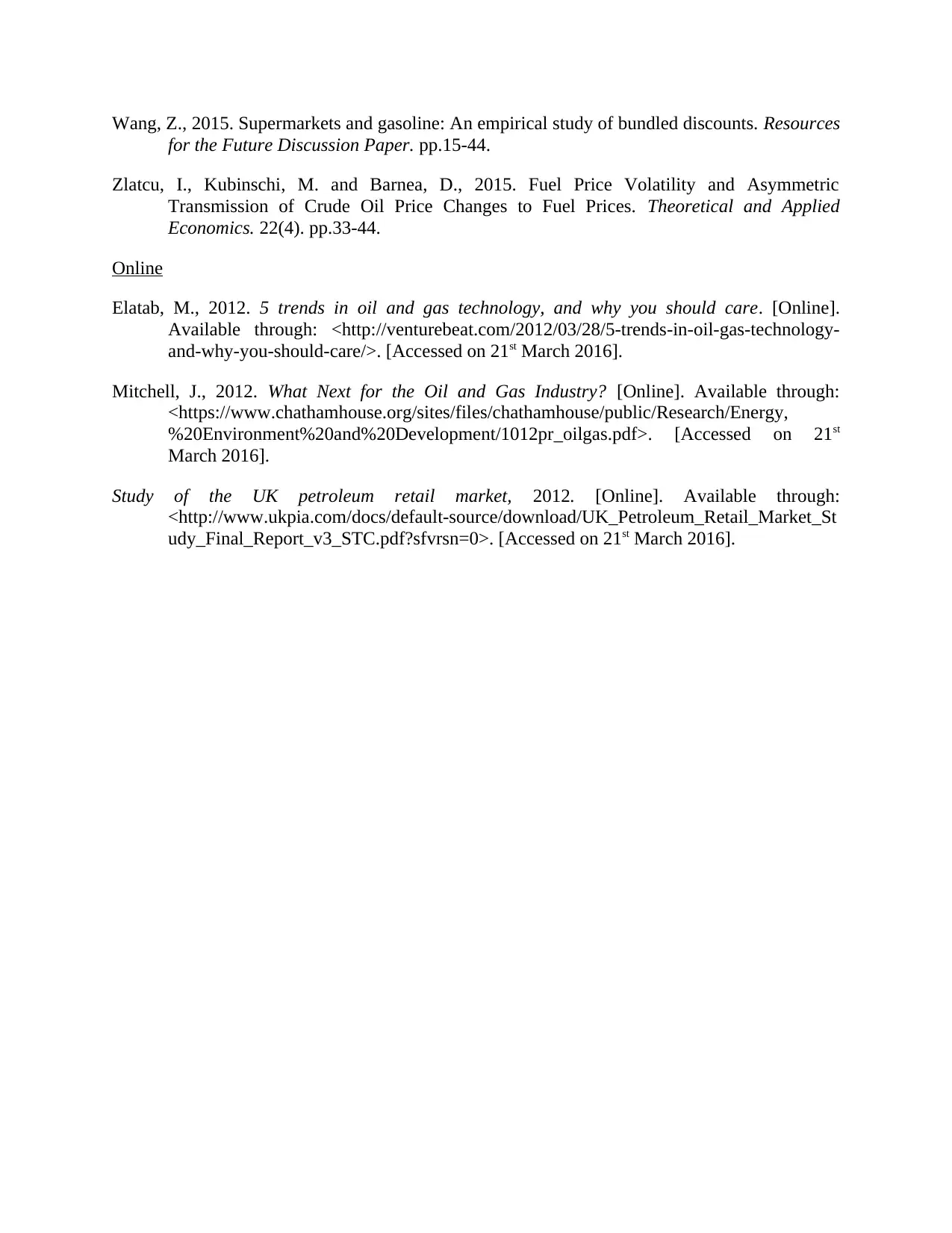
Wang, Z., 2015. Supermarkets and gasoline: An empirical study of bundled discounts. Resources
for the Future Discussion Paper. pp.15-44.
Zlatcu, I., Kubinschi, M. and Barnea, D., 2015. Fuel Price Volatility and Asymmetric
Transmission of Crude Oil Price Changes to Fuel Prices. Theoretical and Applied
Economics. 22(4). pp.33-44.
Online
Elatab, M., 2012. 5 trends in oil and gas technology, and why you should care. [Online].
Available through: <http://venturebeat.com/2012/03/28/5-trends-in-oil-gas-technology-
and-why-you-should-care/>. [Accessed on 21st March 2016].
Mitchell, J., 2012. What Next for the Oil and Gas Industry? [Online]. Available through:
<https://www.chathamhouse.org/sites/files/chathamhouse/public/Research/Energy,
%20Environment%20and%20Development/1012pr_oilgas.pdf>. [Accessed on 21st
March 2016].
Study of the UK petroleum retail market, 2012. [Online]. Available through:
<http://www.ukpia.com/docs/default-source/download/UK_Petroleum_Retail_Market_St
udy_Final_Report_v3_STC.pdf?sfvrsn=0>. [Accessed on 21st March 2016].
for the Future Discussion Paper. pp.15-44.
Zlatcu, I., Kubinschi, M. and Barnea, D., 2015. Fuel Price Volatility and Asymmetric
Transmission of Crude Oil Price Changes to Fuel Prices. Theoretical and Applied
Economics. 22(4). pp.33-44.
Online
Elatab, M., 2012. 5 trends in oil and gas technology, and why you should care. [Online].
Available through: <http://venturebeat.com/2012/03/28/5-trends-in-oil-gas-technology-
and-why-you-should-care/>. [Accessed on 21st March 2016].
Mitchell, J., 2012. What Next for the Oil and Gas Industry? [Online]. Available through:
<https://www.chathamhouse.org/sites/files/chathamhouse/public/Research/Energy,
%20Environment%20and%20Development/1012pr_oilgas.pdf>. [Accessed on 21st
March 2016].
Study of the UK petroleum retail market, 2012. [Online]. Available through:
<http://www.ukpia.com/docs/default-source/download/UK_Petroleum_Retail_Market_St
udy_Final_Report_v3_STC.pdf?sfvrsn=0>. [Accessed on 21st March 2016].

You're viewing a preview
Unlock full access by subscribing today!
1 out of 15
Related Documents
Your All-in-One AI-Powered Toolkit for Academic Success.
+13062052269
info@desklib.com
Available 24*7 on WhatsApp / Email
![[object Object]](/_next/static/media/star-bottom.7253800d.svg)
Unlock your academic potential
© 2024 | Zucol Services PVT LTD | All rights reserved.





